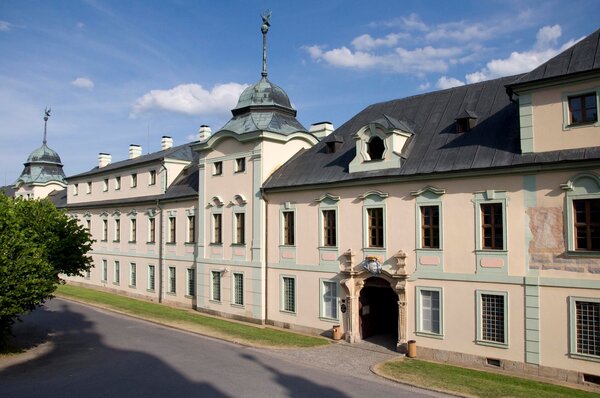History

Before the current Baroque chateau, a medieval fort was built in the northwestern corner of the area.
In 1560, the Manětín domain was bought from the Schwambergs by the House of Hrobčice, who, unlike the previous owners, made Manětín their place of residence. Thus, the town became a center of an independent domain. During the rule of Jerome of Hrobčice (+1604), shortly before 1600, the fort was enlarged and rebuilt to a chateau. The building already took most of the current chateau area, including the park. The representative nature of this reconstruction is proven by the fragments of the Renaissance paintings on the façades, revealed during the reconstruction in May 1997 on the northern wall of the chateau, near the Church of St. John the Baptist.
After the uneasy period of the Thirty Years War, Charles Maximilian Lazansky (1658-1695) ordered a reconstruction after 1670 that removed the Renaissance nature of the building. This reconstruction is partially dated by the year 1678 on the portal of the yard.
The reconstruction in high Baroque style was done by Wenzel Josef Lazansky and his wife Maria Gabriela after a big fire in 1712. The architect who gave Manětín the Baroque appearance was Thomas Hafenecker (1669-1730). The construction was realized by Johann Georg Hess, master builder from Reutt, Tyrolia. The chateau was significantly enlarged. A long two-floor building in the L-shape was built, with the adjacent yard, forming the southern side of the square. The oblong front face has 33 window axes, and is divided by three portals. On the western side, the chateau is connected with the oratory of the Church of St. John the Baptist by a roofed corridor.
After 1945, the chateau was confiscated and given to the National Farm and Forest Management. It became headquarters of the forest management company, and offered apartments for its employees. In 1959, the hall and the former library opened for the public, as the “Society of Friends of the Manětín Region” established a local museum here. Thanks to the efforts of the Society leader, Václav Žalman, part of the confiscated equipment was returned to Manětín in 1962. In the late 19701, the Manětín museum became part of the district museum in Mariánská Týnice. The exhibition gradually grew. In 1988, the district museum took over the chateau building as well, and started the reconstruction. On January 1, 2002 Chateau Manětín and the surrounding park became a national heritage site. Currently, it’s managed by the National Heritage Institute.
The garden adjacent to the chateau building was already documented in 1604. It was probably established during the reconstruction of the fort to the Renaissance chateau, when it was property of the Hrobčický house. After the fire in 1712, first the buildings were reconstructed, then the garden. A typical high Baroque garden composition was used here, with a distinct central axis from the entrance arch in the southern face of the chateau, to the center of the brewery, emphasized by the Baroque portal. There were also two lateral axes: between the gate of the carriage hall and the pool in the flower garden, and between the carriage hall and the orangery, built probably in 1734.
In the early 19th century, a park in English natural landscape style was established south of the Manětín Creek. A pond was made here, a hermitage, and a gazebo on an artificial hill. The decorative garden in Baroque style next to the chateau remained independent. After 1945, the park was devastated; for example, a large pool in the center of the garden was filled up. In the 1990s, the partial restoration to the Baroque style began, modeled by the appearance from 1790. Fences and woodsheds built by previous tenants were removed, together with some trees and bushes considered unworthy by the dendrological research, and the pool in the center was cleaned.
Text: Mgr. Martina Matušková